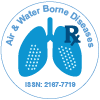A short Note on Airborne and Waterborne Diseases
Received Date: Apr 01, 2024 / Accepted Date: Apr 29, 2024 / Published Date: Apr 29, 2024
Abstract
Airborne and waterborne diseases represent significant public health challenges globally, particularly in regions with inadequate sanitation infrastructure and poor access to clean water and air quality management. These diseases are caused by a variety of pathogens such as bacteria, viruses, fungi, and parasites, which can be transmitted through the air or contaminated water sources. The transmission of airborne diseases occurs through the inhalation of infectious particles suspended in the air, while waterborne diseases are contracted through the ingestion of contaminated water or food. Key factors contributing to the spread of airborne diseases include urbanization, population density, industrial activities, and environmental pollution. Similarly, waterborne diseases thrive in areas where water sources are polluted with human and animal waste, agricultural runoff, and industrial discharge. Climate change further exacerbates the transmission of these diseases by altering environmental conditions that favor the proliferation of pathogens and vectors.
Preventing and controlling airborne and waterborne diseases require multidisciplinary approaches involving public health interventions, sanitation improvements, access to clean water and sanitation facilities, vaccination programs, and environmental management strategies. These efforts encompass surveillance and early detection of outbreaks, education on hygiene practices, infrastructure development for water and sanitation, and implementation of appropriate treatment technologies.
This review provides an overview of common airborne and waterborne diseases, their epidemiology, transmission dynamics, and the challenges associated with their control. It also highlights current strategies and technologies for disease prevention and control, emphasizing the importance of integrated approaches to mitigate the impact of these diseases on public health.
Citation: Vikrant S (2024) A short Note on Airborne and Waterborne Diseases. Air Water Borne Dis 13: 226.
Copyright: © 2024 Vikrant S. This is an open-access article distributed under the terms of the Creative Commons Attribution License, which permits unrestricted use, distribution, and reproduction in any medium, provided the original author and source are credited.
Share This Article
Open Access Journals
Article Usage
- Total views: 512
- [From(publication date): 0-2024 - Apr 06, 2025]
- Breakdown by view type
- HTML page views: 326
- PDF downloads: 186
